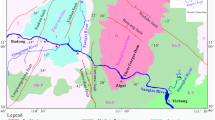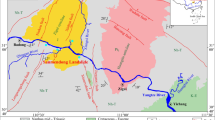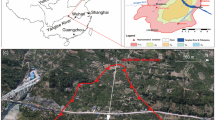Abstract
Landslide deformation in the Three Gorges Reservoir Area (TGRA) is mainly caused by water level fluctuations; however, it is also influenced by rainfall. The Tanjiawan landslide is one of the most notable landslides affected by rainfall in the TGRA. This study investigates the landslide’s deformation mechanism by analysing reconnaissance data, which are surface deformation survey data, and GPS displacement data for the last 16 years along with several types of monitoring data from equipment installed in 2020. The landslide has undergone significant deformation since September 2014. Subsequent rainfall events have caused severe deformation, and tension cracks have appeared in many parts of the landslide. Owing to the slope structure and rainfall events, a deformation feature has developed, in which sliding masses no. 1 and no. 2 are the active and secondary deformation zones, respectively. The surface displacement of the landslide is clearly step-like, and its episodic deformation is controlled by rainfall. Landslide deformation leads to the development of cracks in the slope, producing dominant seepage channels. As rainwater enters belowground along the cracks and with the influence of the bedrock morphology, the groundwater level in the middle and rear parts, and hence, the hydrodynamic pressure, increase, thereby activating landslide deformation. Both continuous rainfall and heavy rain are responsible for this phenomenon; sliding mass no. 1 shows an overall downward motion. Finally, the seismic data recorded by microcore piles and the change rate in soil moisture content after rainfalls can currently be used for reliable early warnings of landslide instability.



















Similar content being viewed by others
Change history
08 October 2022
A Correction to this paper has been published: https://doi.org/10.1007/s10064-022-02968-6
References
Alonso E, Gens A, Lloret A, Delahaye C (1995) Effect of rain infiltration on the stability of slopes. In: Proceedings of the first international conference on unsaturated soils, UNSAT’95, Paris, France, vol 1, pp 241–249
Baum RL, Godt JW (2010) Early warning of rainfall-induced shallow landslides and debris flows in the USA. Landslides 7:259–272. https://doi.org/10.1007/s10346-009-0177-0
Bordoni M, Meisina C, Valentino R et al (2015) Hydrological factors affecting rainfall-induced shallow landslides: from the field monitoring to a simplified slope stability analysis. Eng Geol 193:19–37. https://doi.org/10.1016/j.enggeo.2015.04.006
Bordoni M, Bittelli M, Valentino R et al (2021) Observations on soil-atmosphere interactions after long-term monitoring at two sample sites subjected to shallow landslides. Bull Eng Geol Environ 80:7467–7491. https://doi.org/10.1007/s10064-021-02334-y
Damiano E (2019) Effects of layering on triggering mechanisms of rainfall-induced landslides in unsaturated pyroclastic granular soils. Can Geotech J 56(9):1278–1290. https://doi.org/10.1139/cgj-2018-0040
Ding JX, Yang ZF, Shang YJ et al (2006) A new method for spatio-temporal prediction of rainfall- induced landslide. Science in China 4:421–430. https://doi.org/10.1007/s11430-006-0421-6
Du J, Yin K, Lacasse S (2013) Displacement prediction in colluvial landslides, Three Gorges Reservoir. China Landslides 10(2):203–218. https://doi.org/10.1007/s10346-012-0326-8
Dikshit A, Satyam N (2019) Probabilistic rainfall thresholds in Chibo, India: estimation and validation using monitoring system. J Mt Sci 16:870–883. https://doi.org/10.1007/s11629-018-5189-6
Godt JW, Baum RL, Lu N (2009) Landsliding in partially saturated materials. Geophys Res Lett 36:L02403. https://doi.org/10.1029/2008GL035996
Hojat A, Arosio D, Ivanov VI et al (2019) Geoelectrical characterization and monitoring of slopes on a rainfall-triggered landslide simulator. J Appl Geophys. https://doi.org/10.1016/j.jappgeo.2019.103844
Huang D, Luo SL, Zhong Z et al (2020a) Analysis and modeling of the combined effects of hydrological factors on a reservoir bank slope in the Three Gorges Reservoir area. China Engineering Geology 279. https://doi.org/10.1016/j.enggeo.2020.105858
Huang XH, Guo F, Deng ML et al (2020b) Understanding the deformation mechanism and threshold reservoir level of the floating weight-reducing landslide in the Three Gorges Reservoir area, China. Landslides 17:2879–2894. https://doi.org/10.1007/s10346-020-01435-1
Liu JQ, Tang HM, Li Q et al (2018) Multi-sensor fusion of data for monitoring of Huangtupo landslide in the three Gorges Reservoir (China). Geomat Nat Haz Risk 9(1):881–891. https://doi.org/10.1080/19475705.2018.1478892
Lora M, Camporese M, Troch PA, Salandin P (2016) Rainfall-triggered shallow landslides: infiltration dynamics in a physical hillslope model. Hydrol Process 30(18):3239–3251. https://doi.org/10.1002/hyp.10829
Mirus BB, Becker RE, Baum RL et al (2018) Integrating real-time subsurface hydrologic monitoring with empirical rainfall thresholds to improve landslide early warning. Landslides 15:1909–1919. https://doi.org/10.1007/s10346-018-0995-z
Rahardjo H, Lim TT, Leong EC et al (2005) Response of a residual soil slope to rainfall. Can Geotech J 42:340–351. https://doi.org/10.1139/t04-101
SL237–1999 (1999) Specification of soil test. Ministry of Water Resources, China (in Chinese)
Song K, Wang F, Zuo Q et al (2020) Successful disaster management of the July 2020 Shaziba landslide triggered by heavy rainfall in Mazhe Village, Enshi City, Hubei Province. China Landslides (prepublish). https://doi.org/10.1007/s10346-020-01565-6
Sun P, Wang G, Wu LZ et al (2019) Physical model experiments for shallow failure in rainfall-triggered Loess slope, Northwest China. Bull Eng Geol Env 78(6):4363–4382. https://doi.org/10.1007/s10064-018-1420-5
Tang H, Wasowski J, Juang CH (2019) Geohazards in the Three Gorges Reservoir area, China – lessons learned from decades of research. Eng Geol 261. https://doi.org/10.1016/j.enggeo.2019.105267
Tang M, Xu Q, Huang R (2015) Site monitoring of suction and temporary pore water pressure in an ancient landslide in the Three Gorges Reservoir area. China Environmental Earth Sciences 73(9):5601–5609. https://doi.org/10.1007/s12665-014-3814-4
Wang FW, Zhang YM, Huo ZT et al (2008) Movement of the Shuping landslide in the first four years after the initial impoundment of the Three Gorges Dam Reservoir. China Landslides 5(3):321–329. https://doi.org/10.1007/s10346-008-0128-1
Wang JE, Xiang W, Lu N (2014) Landsliding triggered by reservoir operation: a general conceptual model with a case study at Three Gorges Reservoir. Acta Geotech 9(5):771–788. https://doi.org/10.1007/s11440-014-0315-2
Wang L, Li G, Chen Y et al (2021a) Field model test on the disaster mechanism of artificial cut slope rainfall in Southern Jiangxi. Rock Soil Mech 42(3): 846–854. https://doi.org/10.16285/j.rsm.2020.1129
Wang SM, Pan YC, Wang L et al (2021b) Deformation characteristics, mechanisms, and influencing factors of hydrodynamic pressure landslides in the Three Gorges Reservoir: a case study and model test study. Bull Eng Geol Environ 80(4):3513–3533. https://doi.org/10.1007/s10064-021-02120-w
Wu Q, Tang H, Ma X et al (2019) Identification of movement characteristics and causal factors of the Shuping landslide based on monitored displacements. Bull Eng Geol Env 78(3):2093–2106. https://doi.org/10.1007/s10064-018-1237-2
Wu T, Jia J, Jiang N et al (2020) Model test of deformation evolution and multi factor prediction of anchorage slope stability under rainfall condition. J Earth Sci 31:1109–1120. https://doi.org/10.1007/s12583-020-1343-5
Zhou C, Yin K, Cao Y et al (2016) Application of time series analysis and PSO–SVM model in predicting the Bazimen landslide in the Three Gorges Reservoir, China. Eng Geol 204:108–120. https://doi.org/10.1016/j.enggeo.2016.02.009
Acknowledgements
Some data of the manuscript were collected with the assistance of Yichang Geological Environment Monitoring and Protection station.
Funding
This work was supported by the National Natural Science Foundation Key Projects of China (No. U21A2031) and the China Postdoctoral Science Foundation (2021M701969).
Author information
Authors and Affiliations
Corresponding author
Ethics declarations
Conflict of interest
The authors declare no competing interests.
Additional information
The original online version of this article was revised: Originally, the article was published with problem in the organization name of the authors. "China" has been omitted from the affiliations 1 and 2 during processing.
Rights and permissions
Springer Nature or its licensor holds exclusive rights to this article under a publishing agreement with the author(s) or other rightsholder(s); author self-archiving of the accepted manuscript version of this article is solely governed by the terms of such publishing agreement and applicable law.
About this article
Cite this article
Wang, L., Chen, Y., Wang, S. et al. Response of landslide deformation to rainfall based on multi-index monitoring: a case of the Tanjiawan landslide in the Three Gorges Reservoir. Bull Eng Geol Environ 81, 231 (2022). https://doi.org/10.1007/s10064-022-02732-w
Received:
Accepted:
Published:
DOI: https://doi.org/10.1007/s10064-022-02732-w




